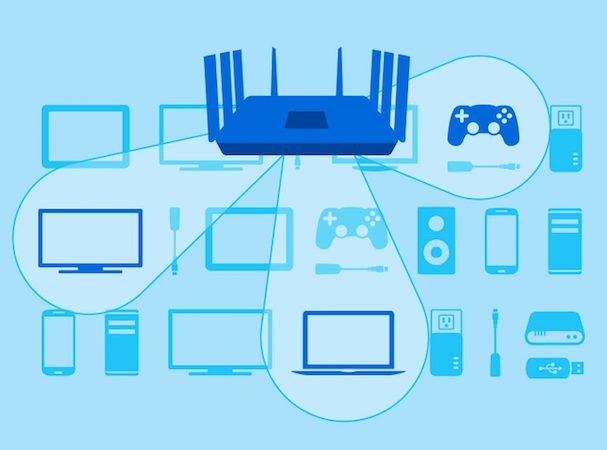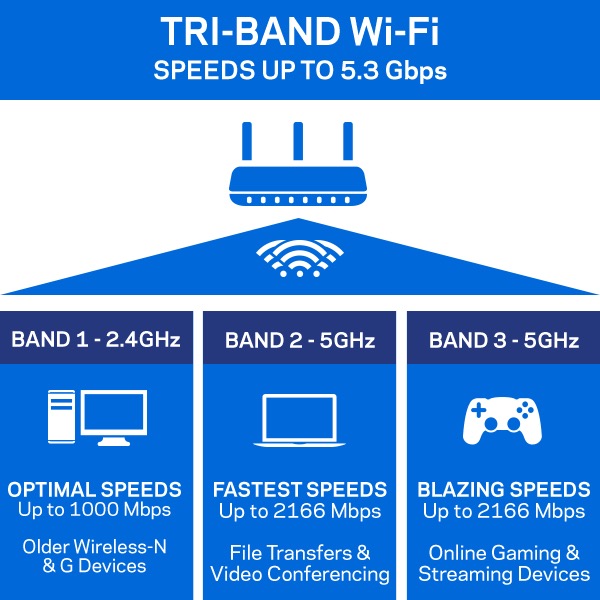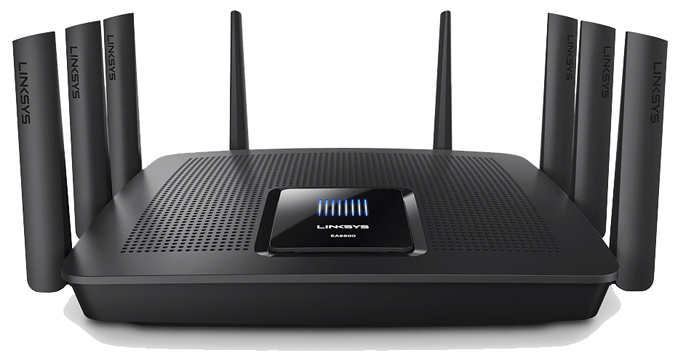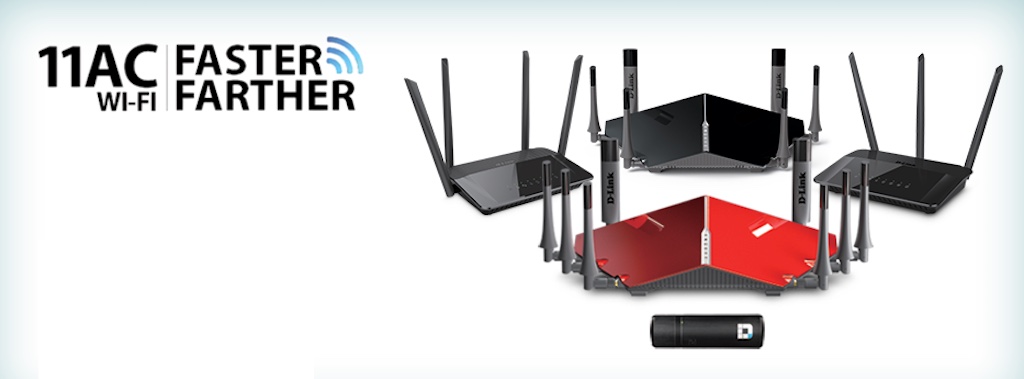Wi-Fi is Critical to Performance (Because Everything is Connected)
A decade or two ago, when we said that high tech devices were connected, that often meant with a cable. Ethernet, USB or whatever. And the connection was usually directly to another device. Your computer might have been connected to your router with an Ethernet cable, your computer was connected to your printer with a USB cable. That kind of thing. Wi-Fi was around of course, but just coming into mainstream adoption. Cables still made great stocking stuffers … Today, almost everything is connected and the term doesn’t mean quite the same thing. Wi-Fi is critical and that makes the wireless router key to connectivity.

Devices still connect to each other—my computer is connected to my printer—but the cables are gone and that connection is wireless, using Wi-Fi. Most of the connected gear in your home connects to the internet, and again, that connection is wirelessly via Wi-Fi. The number of connected devices has also exploded. An average home today probably has computers, smartphones, tablets, game consoles, smart TVs and even devices like cameras, smart thermostats, smart locks and smart lights that are all connected.
All of these devices represent very cool technology, but the one thing they all have in common is a reliance on Wi-Fi to perform at their best when installed or used in your home.
The problem is that many homes are still equipped with previous generation wireless routers, making that Wi-Fi connection the weakest link. So if you want to really make someone’s day, giving them the gift of better Wi-Fi has the potential to make all of their connected devices perform better. And that’s a tough gift to top.
Why Homes Need 802.11ac Wi-Fi
The Wi-Fi standard has gone through multiple generations and 802.11ac is the fifth. Each version has introduced new technology that’s optimized for the changing needs of wireless networking, while delivering greater speed. The previous generation of Wi-Fi was 802.11n. It was first introduced in 2009 and increased throughput on Wi-Fi routers to roughly 450Mbps. And it was great.
But today’s home Wi-Fi demands are an order of magnitude higher than they were back then. In 2009, smartphones were just starting to take off in popularity, the iPad had yet to debut and kick off the tablet revolution, Netflix had only recently launched its video streaming service and content wasn’t high definition or unlimited, and gamers were rocking an Xbox 360 or PS3.
802.11n Wi-Fi provided the throughput needed for the most common online tasks of the time, web browsing, online gaming and relatively light duty video streaming.
 802.11ac is the latest generation in Wi-Fi and the standard became official in 2014, although 802.11ac—or Gigabit—Wi-Fi routers started to hit the market the year before. 802.11ac was designed to meet the needs of modern homes that are increasingly full of connected devices, many with high bandwidth requirements. The base spec boosted maximum throughput to 1300Mbps, for a big speed increase. It also incorporated advanced technology like beam-forming, so routers could actively track connected devices and project a targeted beam of Wi-Fi in their direction as they move around. 802.11ac also supports more concurrent connections, so multiple devices can be connected to your Wi-Fi network without the performance bogging down.
802.11ac is the latest generation in Wi-Fi and the standard became official in 2014, although 802.11ac—or Gigabit—Wi-Fi routers started to hit the market the year before. 802.11ac was designed to meet the needs of modern homes that are increasingly full of connected devices, many with high bandwidth requirements. The base spec boosted maximum throughput to 1300Mbps, for a big speed increase. It also incorporated advanced technology like beam-forming, so routers could actively track connected devices and project a targeted beam of Wi-Fi in their direction as they move around. 802.11ac also supports more concurrent connections, so multiple devices can be connected to your Wi-Fi network without the performance bogging down.
People are naturally resistant to upgrading their Wi-Fi routers. Setting one up means taking something that has been working for years, replacing it with a new router that has to be configured. And then all those connected devices have to be directed to the new Wi-Fi access point. No one likes doing that, so the majority of home routers remain older, 802.11n models and the majority of homes are putting up with Wi-Fi performance that’s subpar and only getting worse.
Give someone the gift of a new Wi-Fi router and they’ll find set-up is much easier than it used to be. Most manufacturers offer wizards and app-based configuration that largely automates the process. The OnHub AC1900 wireless router from Google and TP-Link takes that to a whole new level by automatically updating itself for performance and security, while offering network optimization suggestions.
Once someone makes the switch to 802.11ac W-Fi, everything connected will get better. No more waiting for streaming videos to buffer, no more game lag, no more all-day downloads for game or OS updates and no dropped connections because too many things are connected at once.
Making Wi-Fi better makes almost everything better.
The Latest 802.11ac Wi-Fi Routers Are a Huge Improvement
First generation 802.11ac Wi-Fi routers were a big improvement over 802.11n. But the standard has continued to evolve even as demands—like Ultra HD 4K streaming video—have continued to increase.

The latest generation of Gigabit routers offer a huge improvement over that first generation and one that will represent a significant wireless improvement for power users. For example, I moved to an 802.11ac Apple Airport extreme in 2013. It was great, up until this year. My teenage kids all got iPhones (as did their friends who are frequently hanging out here), we upgraded our Netflix subscription to handle multiple devices, we added a new Apple TV to bring the total to five active in the house, subscribed to Apple Music, and Xbox Live has become increasingly popular. Add in a bunch of smart devices, including lights, electrical outlets, locks and cameras, and our Wi-Fi network was beginning to big down again.
For the past month I’ve been using a new Linksys Max-Stream AC5400 Wi-Fi router. Part of the latest generation of Gigabit Wi-Fi routers, this one incorporates all the latest Wi-Fi technology, including MU-MIMO support, Tri-band radios, Smart connect band steering, and four data streams. It’s designed to support 4K video streaming, high user volume and extended coverage. My three year-old 802.11ac router maxed out at 1300Mbps throughput. The new one manages an incredible 5300Mbps!

As a result of switching from a first generation 802.11ac router to this latest generation, we have banished buffering, online gaming complaints have disappeared, we are finally able to take full advantage of our broadband internet connection speed on all devices and even my office (a Wi-Fi trouble spot due to its location) gets great connectivity.
So if you are looking for the ultimate tech gift for someone this holiday season, consider the latest generation of 802.11ac wireless routers. Because better Wi-Fi makes everything else better, and as they add more connected devices, better Wi-Fi is literally a gift that keeps giving.




